Applications of Surface Plasmon Resonance in Heparan Sulfate Interactome Research
Abstract
1. Introduction
2. Heparan Sulfate (HS)–Heparan Sulfate-Binding Protein (HSBP) Interactome
3. Surface Plasmon Resonance
3.1. Principle of SPR
3.2. Typical Workflow of SPR
4. SPR Applications in HS-Based Interactome
4.1. SPR Application in Heparin Research
4.2. SPR Application in Antiviral and Antimicrobial Discovery
4.3. SPR Application in Neurodegenerative Diseases Research
4.4. SPR Application in Cancer Research
4.5. SPR Application in the Research of Inflammatory Diseases
5. Conclusions
Author Contributions
Funding
Acknowledgments
Conflicts of Interest
References
- Nguyen, H.H.; Park, J.; Kang, S.; Kim, M. Surface Plasmon Resonance: A Versatile Technique for Biosensor Applications. Sensors 2015, 15, 10481. [Google Scholar] [CrossRef] [PubMed]
- Piliarik, M.; Vaisocherová, H.; Homola, J. Surface Plasmon Resonance Biosensing. Methods Mol. Biol. 2009, 503, 65–88. [Google Scholar] [CrossRef] [PubMed]
- Zimmermann, P.; Egea-Jimenez, A.L. Study of PDZ–Peptide and PDZ–Lipid Interactions by Surface Plasmon Resonance/BIAcore. Methods Mol. Biol. 2021, 2256, 75–87. [Google Scholar] [CrossRef]
- Utt, M.; Danielsson, B.; Wadström, T. Helicobacter Pylori Vacuolating Cytotoxin Binding to a Putative Cell Surface Receptor, Heparan Sulfate, Studied by Surface Plasmon Resonance. FEMS Immunol. Med. Microbiol. 2001, 30, 109–113. [Google Scholar] [CrossRef]
- Zhang, J.; Liu, B.; Chen, H.; Zhang, L.; Jiang, X. Application and Method of Surface Plasmon Resonance Technology in the Preparation and Characterization of Biomedical Nanoparticle Materials. Int. J. Nanomed. 2024, 19, 7049–7069. [Google Scholar] [CrossRef] [PubMed]
- Moriwaki, H.; Yamada, K.; Nakanishi, H. Evaluation of the Interaction between Pesticides and a Cell Membrane Model by Surface Plasmon Resonance Spectroscopy Analysis. J. Agric. Food Chem. 2017, 65, 5390–5396. [Google Scholar] [CrossRef]
- Zhang, F.; Datta, P.; Dordick, J.S.; Linhardt, R.J. Evaluating Heparin Products for Heparin-Induced Thrombocytopenia Using Surface Plasmon Resonance. J. Pharm. Sci. 2020, 109, 975–980. [Google Scholar] [CrossRef]
- Kwon, P.S.; Oh, H.; Kwon, S.J.; Jin, W.; Zhang, F.; Fraser, K.; Hong, J.J.; Linhardt, R.J.; Dordick, J.S. Sulfated Polysaccharides Effectively Inhibit SARS-CoV-2 in Vitro. Cell Discovery 2020, 6, 50. [Google Scholar] [CrossRef]
- Eilts, F.; Bauer, S.; Fraser, K.; Dordick, J.S.; Wolff, M.W.; Linhardt, R.J.; Zhang, F. The Diverse Role of Heparan Sulfate and Other GAGs in SARS-CoV-2 Infections and Therapeutics. Carbohydr. Polym. 2023, 299, 120167. [Google Scholar] [CrossRef]
- Song, Y.; Singh, A.; Feroz, M.M.; Xu, S.; Zhang, F.; Jin, W.; Kumar, A.; Azadi, P.; Metzger, D.W.; Linhardt, R.J.; et al. Seaweed-Derived Fucoidans and Rhamnan Sulfates Serve as Potent Anti-SARS-CoV-2 Agents with Potential for Prophylaxis. Carbohydr. Polym. 2024, 337, 122156. [Google Scholar] [CrossRef]
- Zhang, F.; He, P.; Rodrigues, A.L.; Jeske, W.; Tandon, R.; Bates, J.T.; Bierdeman, M.A.; Fareed, J.; Dordick, J.; Linhardt, R.J. Potential Anti-SARS-CoV-2 Activity of Pentosan Polysulfate and Mucopolysaccharide Polysulfate. Pharmaceuticals 2022, 15, 258. [Google Scholar] [CrossRef] [PubMed]
- Clausen, T.M.; Sandoval, D.R.; Spliid, C.B.; Pihl, J.; Perrett, H.R.; Painter, C.D.; Narayanan, A.; Majowicz, S.A.; Kwong, E.M.; McVicar, R.N.; et al. SARS-CoV-2 Infection Depends on Cellular Heparan Sulfate and ACE2. Cell 2020, 183, 1043. [Google Scholar] [CrossRef] [PubMed]
- Capila, I.; Linhardt, R.J. Heparin–Protein Interactions. Angew. Chem. Int. Ed. Engl. 2002, 41, 390–412. [Google Scholar] [CrossRef]
- Shi, D.; Sheng, A.; Chi, L. Glycosaminoglycan-Protein Interactions and Their Roles in Human Disease. Front. Mol. Biosci. 2021, 8, 639666. [Google Scholar] [CrossRef]
- Xu, D.; Esko, J.D. Demystifying Heparan Sulfate–Protein Interactions. Annu. Rev. Biochem. 2014, 83, 129. [Google Scholar] [CrossRef]
- Gómez Toledo, A.; Sorrentino, J.T.; Sandoval, D.R.; Malmström, J.; Lewis, N.E.; Esko, J.D. A Systems View of the Heparan Sulfate Interactome. J. Histochem. Cytochem. 2021, 69, 105–119. [Google Scholar] [CrossRef]
- Mah, D.; Zhao, J.; Liu, X.; Zhang, F.; Liu, J.; Wang, L.; Linhardt, R.; Wang, C. The Sulfation Code of Tauopathies: Heparan Sulfate Proteoglycans in the Prion Like Spread of Tau Pathology. Front. Mol. Biosci. 2021, 8, 671458. [Google Scholar] [CrossRef] [PubMed]
- Axelsson, J.; Xu, D.; Kang, B.N.; Nussbacher, J.K.; Handel, T.M.; Ley, K.; Sriramarao, P.; Esko, J.D. Inactivation of Heparan Sulfate 2-O-Sulfotransferase Accentuates Neutrophil Infiltration during Acute Inflammation in Mice. Blood 2012, 120, 1742. [Google Scholar] [CrossRef]
- Kallapur, S.G.; Akeson, R.A. The Neural Cell Adhesion Molecule (NCAM) Heparin Binding Domain Binds to Cell Surface Heparan Sulfate Proteoglycans. J. Neurosci. Res. 1992, 33, 538–548. [Google Scholar] [CrossRef]
- Faye, C.; Moreau, C.; Chautard, E.; Jetne, R.; Fukai, N.; Ruggiero, F.; Humphries, M.J.; Olsen, B.R.; Ricard-Blum, S. Molecular Interplay between Endostatin, Integrins, and Heparan Sulfate. J. Biol. Chem. 2009, 284, 22029–22040. [Google Scholar] [CrossRef]
- Ballut, L.; Sapay, N.; Chautard, É.; Imberty, A.; Ricard-Blum, S. Mapping of Heparin/Heparan Sulfate Binding Sites on Avβ3 Integrin by Molecular Docking. J. Mol. Recognit. 2013, 26, 76–85. [Google Scholar] [CrossRef] [PubMed]
- Cohen-Kaplan, V.; Ilan, N.; Vlodavsky, I. Heparanase Loosens E-Cadherin-Mediated Cell-Cell Contact via Activation of Src. Front. Oncol. 2020, 10, 2. [Google Scholar] [CrossRef]
- Kawashima, H.; Watanabe, N.; Hirose, M.; Sun, X.; Atarashi, K.; Kimura, T.; Shikata, K.; Matsuda, M.; Ogawa, D.; Heljasvaara, R.; et al. Collagen XVIII, a Basement Membrane Heparan Sulfate Proteoglycan, Interacts with L-Selectin and Monocyte Chemoattractant Protein-1. J. Biol. Chem. 2003, 278, 13069–13076. [Google Scholar] [CrossRef] [PubMed]
- Singh, A.; Kett, W.C.; Severin, I.C.; Agyekum, I.; Duan, J.; Amster, I.J.; Proudfoot, A.E.I.; Coombe, D.R.; Woods, R.J. The Interaction of Heparin Tetrasaccharides with Chemokine CCL5 Is Modulated by Sulfation Pattern and PH. J. Biol. Chem. 2015, 290, 15421. [Google Scholar] [CrossRef]
- Matsushima, K.; Yang, D.; Oppenheim, J.J. Interleukin-8: An Evolving Chemokine. Cytokine 2022, 153, 155828. [Google Scholar] [CrossRef] [PubMed]
- Pichert, A.; Schlorke, D.; Franz, S.; Arnhold, J. Functional Aspects of the Interaction between Interleukin-8 and Sulfated Glycosaminoglycans. Biomatter 2012, 2, 142–148. [Google Scholar] [CrossRef]
- Pisano, C.; Asta, L.; Sbrigata, A.; Balistreri, C.R. A Narrative Review: Syndecans in Aortic Aneurysm Pathogenesis and Course—Biomarkers and Targets? Int. J. Mol. Sci. 2025, 26, 1211. [Google Scholar] [CrossRef]
- Grossdorf, A.; Obser, T.; Wang, Y.; Gorzelanny, C. Single Molecule Force Spectroscopy at Cell Surfaces to Study Physical Properties of Heparan Sulfate Chains and Protein-Heparan Sulfate Interactions. Proteoglycan Res. 2025, 3, e70017. [Google Scholar] [CrossRef]
- He, H.; Ma, C.; Wei, W.; Wang, H.; Lai, Y.; Liu, M.; Sun, S.; Ma, Q.; Lai, J.; Liu, H.; et al. Heparan Sulfate Regulates Myofibroblast Heterogeneity and Function to Mediate Niche Homeostasis during Alveolar Morphogenesis. Nat. Commun. 2025, 16, 1834. [Google Scholar] [CrossRef]
- Syangtan, D.; Al Mahbuba, D.; Masuko, S.; Li, Q.; Elton, A.C.; Zaltsman, Y.; Wrighton, P.J.; Xia, K.; Han, X.; Ouyang, Y.; et al. Heparan Sulfate Regulates the Fate Decisions of Human Pluripotent Stem Cells. Stem Cell Rep. 2025, 20, 102384. [Google Scholar] [CrossRef]
- Mah, D.; Zhu, Y.; Su, G.; Zhao, J.; Canning, A.; Gibson, J.; Song, X.; Stancanelli, E.; Xu, Y.; Zhang, F.; et al. Apolipoprotein E Recognizes Alzheimer’s Disease Associated 3-O Sulfation of Heparan Sulfate. Angew. Chem. Int. Ed. Engl. 2023, 135, e202212636. [Google Scholar] [CrossRef]
- Ng, C.Y.; Whitelock, J.M.; Williams, H.; Kim, H.N.; Medbury, H.J.; Lord, M.S. Macrophages Bind LDL Using Heparan Sulfate and the Perlecan Protein Core. J. Biol. Chem. 2021, 296, 100520. [Google Scholar] [CrossRef]
- Frevert, U.; Sinnis, P.; Cerami, C.; Shreffler, W.; Takacs, B.; Nussenzweig, V. Malaria Circumsporozoite Protein Binds to Heparan Sulfate Proteoglycans Associated with the Surface Membrane of Hepatocytes. J. Exp. Med. 1993, 177, 1287–1298. [Google Scholar] [CrossRef] [PubMed]
- Alvarez-Domínguez, C.; Vázquez-Boland, J.A.; Carrasco-Marín, E.; López-Mato, P.; Leyva-Cobián, F. Host Cell Heparan Sulfate Proteoglycans Mediate Attachment and Entry of Listeria Monocytogenes, and the Listerial Surface Protein ActA Is Involved in Heparan Sulfate Receptor Recognition. Infect. Immun. 1997, 65, 78. [Google Scholar] [CrossRef] [PubMed]
- Yadav, A.K.; Varikuti, S.R.; Kumar, A.; Kumar, M.; Debanth, N.; Rajkumar, H. Expression of Heterologous Heparan Sulphate Binding Protein of Helicobacter Pylori on the Surface of Lactobacillus Rhamnosus GG. 3 Biotech. 2023, 13, 19. [Google Scholar] [CrossRef] [PubMed]
- Urbinati, C.; Milanesi, M.; Lauro, N.; Bertelli, C.; David, G.; D’ursi, P.; Rusnati, M.; Chiodelli, P. HIV-1 Tat and Heparan Sulfate Proteoglycans Orchestrate the Setup of in Cis and in Trans Cell-Surface Interactions Functional to Lymphocyte Trans-Endothelial Migration. Molecules 2021, 26, 7488. [Google Scholar] [CrossRef]
- Abidine, Y.; Liu, L.; Wallén, O.; Trybala, E.; Olofsson, S.; Bergström, T.; Bally, M. Cellular Chondroitin Sulfate and the Mucin-like Domain of Viral Glycoprotein C Promote Diffusion of Herpes Simplex Virus 1 While Heparan Sulfate Restricts Mobility. Viruses 2022, 14, 1836. [Google Scholar] [CrossRef]
- Chaudhuri, D.; Majumder, S.; Giri, K. Repurposing of Drugs Targeting Heparan Sulphate Binding Site of Dengue Virus Envelope Protein: An in Silico Competitive Binding Study. Mol. Divers. 2024, 29, 87–101. [Google Scholar] [CrossRef]
- Koganti, R.; Memon, A.; Shukla, D. Emerging Roles of Heparan Sulfate Proteoglycans in Viral Pathogenesis. Semin. Thromb. Hemost. 2021, 47, 283–294. [Google Scholar] [CrossRef]
- Ramos-Martínez, I.E.; Ramos-Martínez, E.; Segura-Velázquez, R.Á.; Saavedra-Montañez, M.; Cervantes-Torres, J.B.; Cerbón, M.; Papy-Garcia, D.; Zenteno, E.; Sánchez-Betancourt, J.I. Heparan Sulfate and Sialic Acid in Viral Attachment: Two Sides of the Same Coin? Int. J. Mol. Sci. 2022, 23, 9842. [Google Scholar] [CrossRef]
- Matsuzaka, Y.; Yashiro, R. Classification and Molecular Functions of Heparan Sulfate Proteoglycans and Their Molecular Mechanisms with the Receptor. Biologics 2024, 4, 105–129. [Google Scholar] [CrossRef]
- Mochizuki, H.; Futatsumori, H.; Suzuki, E.; Kimata, K. A Quantitative Method to Detect Non-Antithrombin-Binding 3-O-Sulfated Units in Heparan Sulfate. J. Biol. Chem. 2021, 296, 100115. [Google Scholar] [CrossRef]
- Schlömmer, C.; Brandtner, A.; Bachler, M. Antithrombin and Its Role in Host Defense and Inflammation. Int. J. Mol. Sci. 2021, 22, 4283. [Google Scholar] [CrossRef]
- Vallet, S.D.; Clerc, O.; Ricard-Blum, S. Glycosaminoglycan-Protein Interactions: The First Draft of the Glycosaminoglycan Interactome. J. Histochem. Cytochem. 2021, 69, 93–104. [Google Scholar] [CrossRef]
- Linhardt, R.J. 2003 Claude S. Hudson Award Address in Carbohydrate Chemistry. Heparin: Structure and Activity. J. Med. Chem. 2003, 46, 2551–2564. [Google Scholar] [CrossRef]
- Han, M.; Zhu, H.; Chen, X.; Luo, X. 6-O-Endosulfatases in Tumor Metastasis: Heparan Sulfate Proteoglycans Modification and Potential Therapeutic Targets. Am. J. Cancer Res. 2024, 14, 897. [Google Scholar] [CrossRef]
- Grigorieva, E.V.; Strokotova, A.V.; Ernberg, I.; Kashuba, V.I. Differential Regulation of Heparan Sulfate Biosynthesis in Fibroblasts Cocultured with Normal vs. Cancerous Prostate Cells. Front. Immunol. 2024, 15, 1440623. [Google Scholar] [CrossRef]
- Ouyang, Y.; Yu, Y.; Zhang, F.; Chen, J.; Han, X.; Xia, K.; Yao, Y.; Zhang, Z.; Linhardt, R.J. Non-Anticoagulant Low Molecular Weight Heparins for Pharmaceutical Applications. J. Med. Chem. 2019, 62, 1067–1073. [Google Scholar] [CrossRef] [PubMed]
- Jin, W.; He, X.; Long, L.; Fang, Q.; Wei, B.; Sun, J.; Zhang, W.; Wang, H.; Zhang, F.; Linhardt, R.J. Structural Characterization and Anti-Lung Cancer Activity of a Sulfated Glucurono-Xylo-Rhamnan from Enteromorpha Prolifera. Carbohydr. Polym. 2020, 237, 116143. [Google Scholar] [CrossRef]
- Zhao, J.; Zhu, Y.; Song, X.; Xiao, Y.; Su, G.; Liu, X.; Wang, Z.; Xu, Y.; Liu, J.; Eliezer, D.; et al. 3-O-Sulfation of Heparan Sulfate Enhances Tau Interaction and Cellular Uptake. Angew. Chem. Int. Ed. Engl. 2020, 59, 1818–1827. [Google Scholar] [CrossRef]
- Forest-Nault, C.; Gaudreault, J.; Henry, O.; Durocher, Y.; De Crescenzo, G. On the Use of Surface Plasmon Resonance Biosensing to Understand IgG-FcγR Interactions. Int. J. Mol. Sci. 2021, 22, 22. [Google Scholar] [CrossRef]
- Zhao, J.; Liu, X.; Kao, C.; Zhang, E.; Li, Q.; Zhang, F.; Linhardt, R.J. Kinetic and Structural Studies of Interactions between Glycosaminoglycans and Langerin. Biochemistry 2016, 55, 4552–4559. [Google Scholar] [CrossRef]
- Ringe, R.P.; Colin, P.; Ozorowski, G.; Allen, J.D.; Yasmeen, A.; Seabright, G.E.; Lee, J.H.; Antanasijevic, A.; Rantalainen, K.; Ketas, T.; et al. Glycan Heterogeneity as a Cause of the Persistent Fraction in HIV-1 Neutralization. PLoS Pathog. 2023, 19, e1011601. [Google Scholar] [CrossRef]
- Shafer, P.; Kelly, L.M.; Hoyos, V. Cancer Therapy With TCR-Engineered T Cells: Current Strategies, Challenges, and Prospects. Front. Immunol. 2022, 13, 835762. [Google Scholar] [CrossRef]
- Beaudet, J.M.; Weyers, A.; Solakyildirim, K.; Yang, B.; Takieddin, M.; Mousa, S.; Zhang, F.; Linhardt, R.J. Impact of Autoclave Sterilization on the Activity and Structure of Formulated Heparin. J. Pharm. Sci. 2011, 100, 3396–3404. [Google Scholar] [CrossRef]
- Zhao, J.; Liu, X.; Malhotra, A.; Li, Q.; Zhang, F.; Linhardt, R.J. Novel Method for Measurement of Heparin Anticoagulant Activity Using SPR. Anal. Biochem. 2017, 526, 39–42. [Google Scholar] [CrossRef] [PubMed]
- Ahmed, I.; Majeed, A.; Powell, R. Heparin Induced Thrombocytopenia: Diagnosis and Management Update. Postgrad. Med. J. 2007, 83, 575–582. [Google Scholar] [CrossRef] [PubMed]
- Douaisi, M.; Paskaleva, E.E.; Fu, L.; Grover, N.; McManaman, C.L.; Varghese, S.; Brodfuehrer, P.R.; Gibson, J.M.; de Joode, I.; Xia, K.; et al. Synthesis of Bioengineered Heparin Chemically and Biologically Similar to Porcine-Derived Products and Convertible to Low MW Heparin. Proc. Natl. Acad. Sci. USA 2024, 121, e2315586121. [Google Scholar] [CrossRef]
- Chen, Y.; Maguire, T.; Hileman, R.E.; Fromm, J.R.; Esko, J.D.; Linhardt, R.J.; Marks, R.M. Dengue Virus Infectivity Depends on Envelope Protein Binding to Target Cell Heparan Sulfate. Nat. Med. 1997, 3, 866–871. [Google Scholar] [CrossRef]
- He, P.; Song, Y.; Jin, W.; Li, Y.; Xia, K.; Kim, S.B.; Dwivedi, R.; Farrag, M.; Bates, J.; Pomin, V.H.; et al. Marine Sulfated Glycans Inhibit the Interaction of Heparin with S-Protein of SARS-CoV-2 Omicron XBB Variant. Glycoconj. J. 2024, 41, 163–174. [Google Scholar] [CrossRef]
- Petitjean, S.J.L.; Eeckhout, S.; Delguste, M.; Zhang, Q.; Durlet, K.; Alsteens, D. Heparin-Induced Allosteric Changes in SARS-CoV-2 Spike Protein Facilitate ACE2 Binding and Viral Entry. Nano Lett. 2023, 23, 11678–11684. [Google Scholar] [CrossRef] [PubMed]
- Kim, S.Y.; Jin, W.; Sood, A.; Montgomery, D.W.; Grant, O.C.; Fuster, M.M.; Fu, L.; Dordick, J.S.; Woods, R.J.; Zhang, F.; et al. Characterization of Heparin and Severe Acute Respiratory Syndrome-Related Coronavirus 2 (SARS-CoV-2) Spike Glycoprotein Binding Interactions. Antiviral Res. 2020, 181, 104873. [Google Scholar] [CrossRef] [PubMed]
- Paiardi, G.; Richter, S.; Oreste, P.; Urbinati, C.; Rusnati, M.; Wade, R.C. The Binding of Heparin to Spike Glycoprotein Inhibits SARS-CoV-2 Infection by Three Mechanisms. J. Biol. Chem. 2022, 298, 101507. [Google Scholar] [CrossRef]
- Chau, T.; Joseph, M.; Solomon, D.M.; Lee, B.; Igneri, L.A. Heparin Resistance in SARS-CoV-2 Infected Patients with Venous Thromboembolism. Hosp. Pharm. 2022, 57, 737–743. [Google Scholar] [CrossRef]
- Gelbach, A.L.; Zhang, F.; Kwon, S.J.; Bates, J.T.; Farmer, A.P.; Dordick, J.S.; Wang, C.; Linhardt, R.J. Interactions between Heparin and SARS-CoV-2 Spike Glycoprotein RBD from Omicron and Other Variants. Front. Mol. Biosci. 2022, 9, 912887. [Google Scholar] [CrossRef]
- Shi, D.; Bu, C.; He, P.; Song, Y.; Dordick, J.S.; Linhardt, R.J.; Chi, L.; Zhang, F. Structural Characteristics of Heparin Binding to SARS-CoV-2 Spike Protein RBD of Omicron Sub-Lineages BA.2.12.1, BA.4 and BA.5. Viruses 2022, 14, 2696. [Google Scholar] [CrossRef]
- Tandon, R.; Sharp, J.S.; Zhang, F.; Pomin, V.H.; Ashpole, N.M.; Mitra, D.; McCandless, M.G.; Jin, W.; Liu, H.; Sharma, P.; et al. Effective Inhibition of SARS-CoV-2 Entry by Heparin and Enoxaparin Derivatives. J. Virol. 2021, 95, e01987-20. [Google Scholar] [CrossRef]
- Samanta, P.; Mishra, S.K.; Pomin, V.H.; Doerksen, R.J. Docking and Molecular Dynamics Simulations Clarify Binding Sites for Interactions of Novel Marine Sulfated Glycans with SARS-CoV-2 Spike Glycoprotein. Molecules 2023, 28, 6413. [Google Scholar] [CrossRef]
- Liyanage, N.M.; Nagahawatta, D.P.; Jayawardena, T.U.; Sanjeewa, K.K.A.; Jayawrdhana, H.H.A.C.K.; Kim, J., II; Jeon, Y.J. Sulfated Polysaccharides from Seaweeds: A Promising Strategy for Combatting Viral Diseases—A Review. Mar. Drugs 2023, 21, 461. [Google Scholar] [CrossRef]
- Zoepfl, M.; Dwivedi, R.; Kim, S.B.; McVoy, M.A.; Pomin, V.H. Antiviral Activity of Marine Sulfated Glycans against Pathogenic Human Coronaviruses. Sci. Rep. 2023, 13, 4804. [Google Scholar] [CrossRef]
- Yang, J.; Song, Y.; Jin, W.; Xia, K.; Burnett, G.C.; Qiao, W.; Bates, J.T.; Pomin, V.H.; Wang, C.; Qiao, M.; et al. Sulfated Glycans Inhibit the Interaction of MERS-CoV Receptor Binding Domain with Heparin. Viruses 2024, 16, 237. [Google Scholar] [CrossRef] [PubMed]
- Morokutti-Kurz, M.; Fröba, M.; Graf, P.; Große, M.; Grassauer, A.; Auth, J.; Schubert, U.; Prieschl-Grassauer, E. Iota-Carrageenan Neutralizes SARS-CoV-2 and Inhibits Viral Replication in Vitro. PLoS ONE 2021, 16, e0237480. [Google Scholar] [CrossRef]
- Terasawa, M.; Hayashi, K.; Lee, J.B.; Nishiura, K.; Matsuda, K.; Hayashi, T.; Kawahara, T. Anti-Influenza A Virus Activity of Rhamnan Sulfate from Green Algae Monostroma Nitidum in Mice with Normal and Compromised Immunity. Mar. Drugs 2020, 18, 254. [Google Scholar] [CrossRef]
- Suzuki, K.; Terasawa, M. Biological Activities of Rhamnan Sulfate Extract from the Green Algae Monostroma Nitidum (Hitoegusa). Mar. Drugs 2020, 18, 228. [Google Scholar] [CrossRef]
- He, P.; Shi, D.; Li, Y.; Xia, K.; Kim, S.B.; Dwivedi, R.; Farrag, M.; Pomin, V.H.; Linhardt, R.J.; Dordick, J.S.; et al. SPR Sensor-Based Analysis of the Inhibition of Marine Sulfated Glycans on Interactions between Monkeypox Virus Proteins and Glycosaminoglycans. Mar. Drugs 2023, 21, 264. [Google Scholar] [CrossRef] [PubMed]
- Song, Y.; He, P.; Rodrigues, A.L.; Datta, P.; Tandon, R.; Bates, J.T.; Bierdeman, M.A.; Chen, C.; Dordick, J.; Zhang, F.; et al. Anti-Sars-CoV-2 Activity of Rhamnan Sulfate from Monostroma Nitidum. Mar. Drugs 2021, 19, 685. [Google Scholar] [CrossRef]
- Zhang, F.; Wang, S.; Yang, J.; Fraser, K.; Gibson, J.M.; Wang, C.; Dordick, J.S.; Tomatsidou, A.; Linhardt, R.J.; Wang, L.; et al. Characterization of heparin interactions with Clostridioides difficile toxins and its potential as anti-CDI therapeutics. Carbohydr. Polym. 2025, 351, 123143. [Google Scholar] [CrossRef]
- Rauch, J.N.; Chen, J.J.; Sorum, A.W.; Miller, G.M.; Sharf, T.; See, S.K.; Hsieh-Wilson, L.C.; Kampmann, M.; Kosik, K.S. Tau Internalization Is Regulated by 6-O Sulfation on Heparan Sulfate Proteoglycans (HSPGs). Sci. Rep. 2018, 8, 6382. [Google Scholar] [CrossRef]
- Jin, W.; Lu, C.; Zhu, Y.; Zhao, J.; Zhang, W.; Wang, L.; Linhardt, R.J.; Wang, C.; Zhang, F. Fucoidans Inhibited Tau Interaction and Cellular Uptake. Carbohydr. Polym. 2023, 299, 120176. [Google Scholar] [CrossRef]
- Chen, M.; Vincent, J.; Ezeanii, A.; Wakade, S.; Yerigenahally, S.; Mor, D.E. Heparan Sulfate Proteoglycans Mediate Prion-like α-Synuclein Toxicity in Parkinson’s in Vivo Models. Life Sci. Alliance 2022, 5, e202201366. [Google Scholar] [CrossRef]
- Mehra, S.; Ghosh, D.; Kumar, R.; Mondal, M.; Gadhe, L.G.; Das, S.; Anoop, A.; Jha, N.N.; Jacob, R.S.; Chatterjee, D.; et al. Glycosaminoglycans Have Variable Effects on -Synuclein Aggregation and Differentially Affect the Activities of the Resulting Amyloid Fibrils. J. Biol. Chem. 2018, 293, 12975–12991. [Google Scholar] [CrossRef]
- Holmes, B.B.; DeVos, S.L.; Kfoury, N.; Li, M.; Jacks, R.; Yanamandra, K.; Ouidja, M.O.; Brodsky, F.M.; Marasa, J.; Bagchi, D.P.; et al. Heparan Sulfate Proteoglycans Mediate Internalization and Propagation of Specific Proteopathic Seeds. Proc. Natl. Acad. Sci. USA 2013, 110, E3138–E3147. [Google Scholar] [CrossRef]
- Cohlberg, J.A.; Li, J.; Uversky, V.N.; Fink, A.L. Heparin and Other Glycosaminoglycans Stimulate the Formation of Amyloid Fibrils from α-Synuclein in Vitro. Biochemistry 2002, 41, 1502–1511. [Google Scholar] [CrossRef]
- Knelson, E.H.; Nee, J.C.; Blobe, G.C. Heparan Sulfate Signaling in Cancer. Trends Biochem. Sci. 2014, 39, 277–288. [Google Scholar] [CrossRef]
- Bartolini, B.; Caravà, E.; Caon, I.; Parnigoni, A.; Moretto, P.; Passi, A.; Vigetti, D.; Viola, M.; Karousou, E. Heparan Sulfate in the Tumor Microenvironment. Adv. Exp. Med. Biol. 2020, 1245, 147–161. [Google Scholar] [CrossRef]
- Yang, H.; Wang, L. Heparan Sulfate Proteoglycans in Cancer: Pathogenesis and Therapeutic Potential. Adv. Cancer Res. 2023, 157, 251–291. [Google Scholar] [CrossRef]
- Hammond, E.; Khurana, A.; Shridhar, V.; Dredge, K. The Role of Heparanase and Sulfatases in the Modification of Heparan Sulfate Proteoglycans within the Tumour Microenvironment and Opportunities for Novel Cancer Therapeutics. Front. Oncol. 2014, 22, 4283. [Google Scholar] [CrossRef]
- Galli, M.; Chatterjee, M.; Grasso, M.; Specchia, G.; Magen, H.; Einsele, H.; Celeghini, I.; Barbieri, P.; Paoletti, D.; Pace, S.; et al. Phase I Study of the Heparanase Inhibitor Roneparstat: An Innovative Approach for Multiple Myeloma Therapy. Haematologica 2018, 103, e469–e472. [Google Scholar] [CrossRef]
- Zhang, J.; Liang, L.; Yang, W.; Ramadan, S.; Baryal, K.; Huo, C.X.; Bernard, J.J.; Liu, J.; Hsieh-Wilson, L.; Zhang, F.; et al. Expedient Synthesis of a Library of Heparan Sulfate-Like “Head-to-Tail” Linked Multimers for Structure and Activity Relationship Studies. Angew. Chem. Int. Ed. Engl. 2022, 61, e202209730. [Google Scholar] [CrossRef]
- Ziarek, J.J.; Veldkamp, C.T.; Zhang, F.; Murray, N.J.; Kartz, G.A.; Liang, X.; Su, J.; Baker, J.E.; Linhardt, R.J.; Volkman, B.F. Heparin Oligosaccharides Inhibit Chemokine (CXC Motif) Ligand 12 (CXCL12) Cardioprotection by Binding Orthogonal to the Dimerization Interface, Promoting Oligomerization, and Competing with the Chemokine (CXC Motif) Receptor 4 (CXCR4) N Terminus. J. Biol. Chem. 2013, 288, 737–746. [Google Scholar] [CrossRef]
- Zhang, F.; Zheng, L.; Cheng, S.; Peng, Y.; Fu, L.; Zhang, X.; Linhardt, R.J. Comparison of the Interactions of Different Growth Factors and Glycosaminoglycans. Molecules 2019, 24, 3360. [Google Scholar] [CrossRef] [PubMed]
- Parish, C.R. The Role of Heparan Sulphate in Inflammation. Nat. Rev. Immunol. 2006, 6, 633–643. [Google Scholar] [CrossRef] [PubMed]
- Liao, Y.E.; Liu, J.; Arnold, K. Heparan Sulfates and Heparan Sulfate Binding Proteins in Sepsis. Front. Mol. Biosci. 2023, 10, 1146685. [Google Scholar] [CrossRef] [PubMed]
- Hippensteel, J.A.; Anderson, B.J.; Orfila, J.E.; McMurtry, S.A.; Dietz, R.M.; Su, G.; Ford, J.A.; Oshima, K.; Yang, Y.; Zhang, F.; et al. Circulating Heparan Sulfate Fragments Mediate Septic Cognitive Dysfunction. J. Clin. Invest. 2019, 129, 1779–1784. [Google Scholar] [CrossRef]
- Liao, Y.E.; Xu, Y.; Arnold, K.; Zhang, F.; Li, J.; Sellers, R.; Yin, C.; Pagadala, V.; Inman, A.M.; Linhardt, R.J.; et al. Using Heparan Sulfate Octadecasaccharide (18-Mer) as a Multi-Target Agent to Protect against Sepsis. Proc. Natl. Acad. Sci. USA 2023, 120, e2209528120. [Google Scholar] [CrossRef]
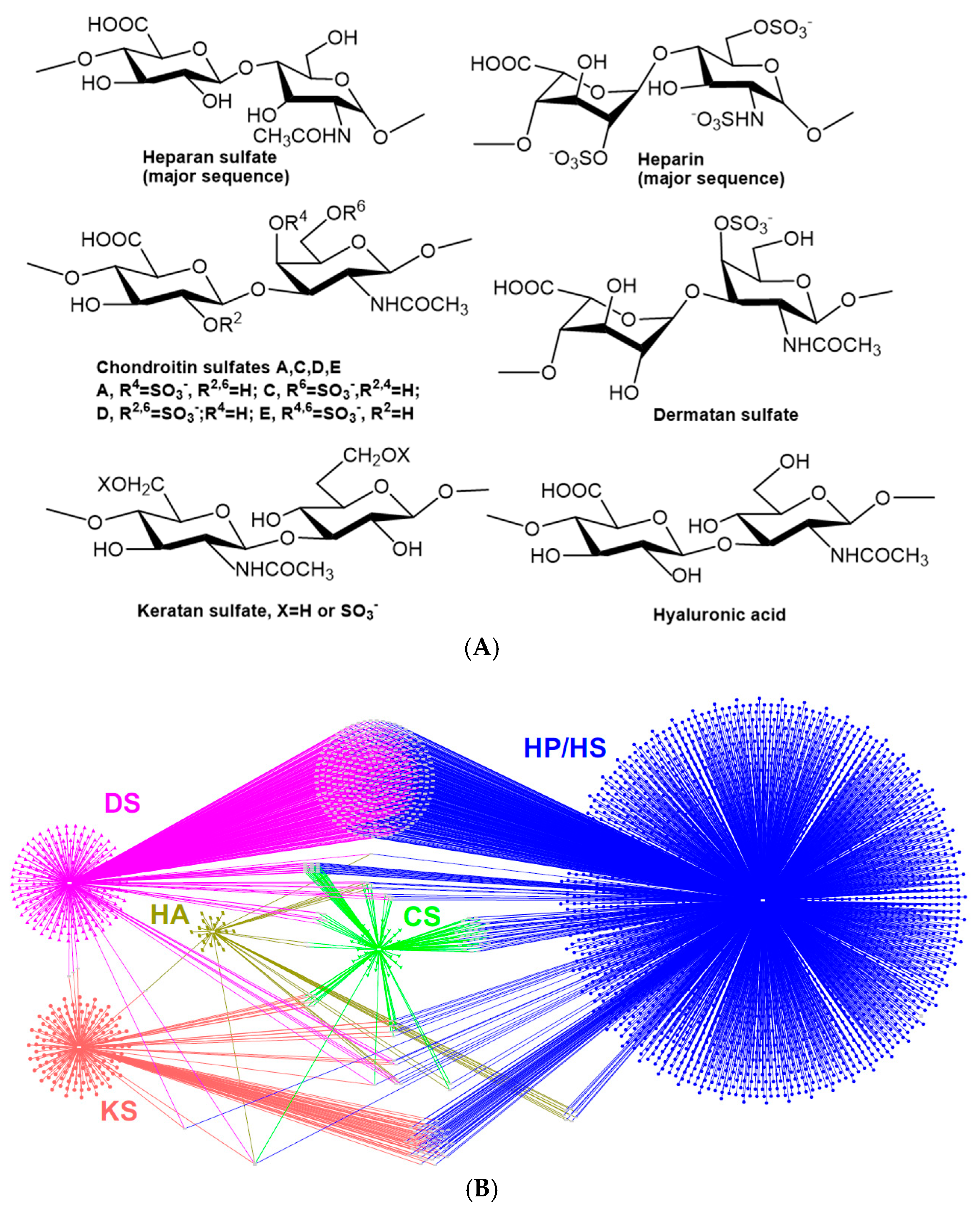
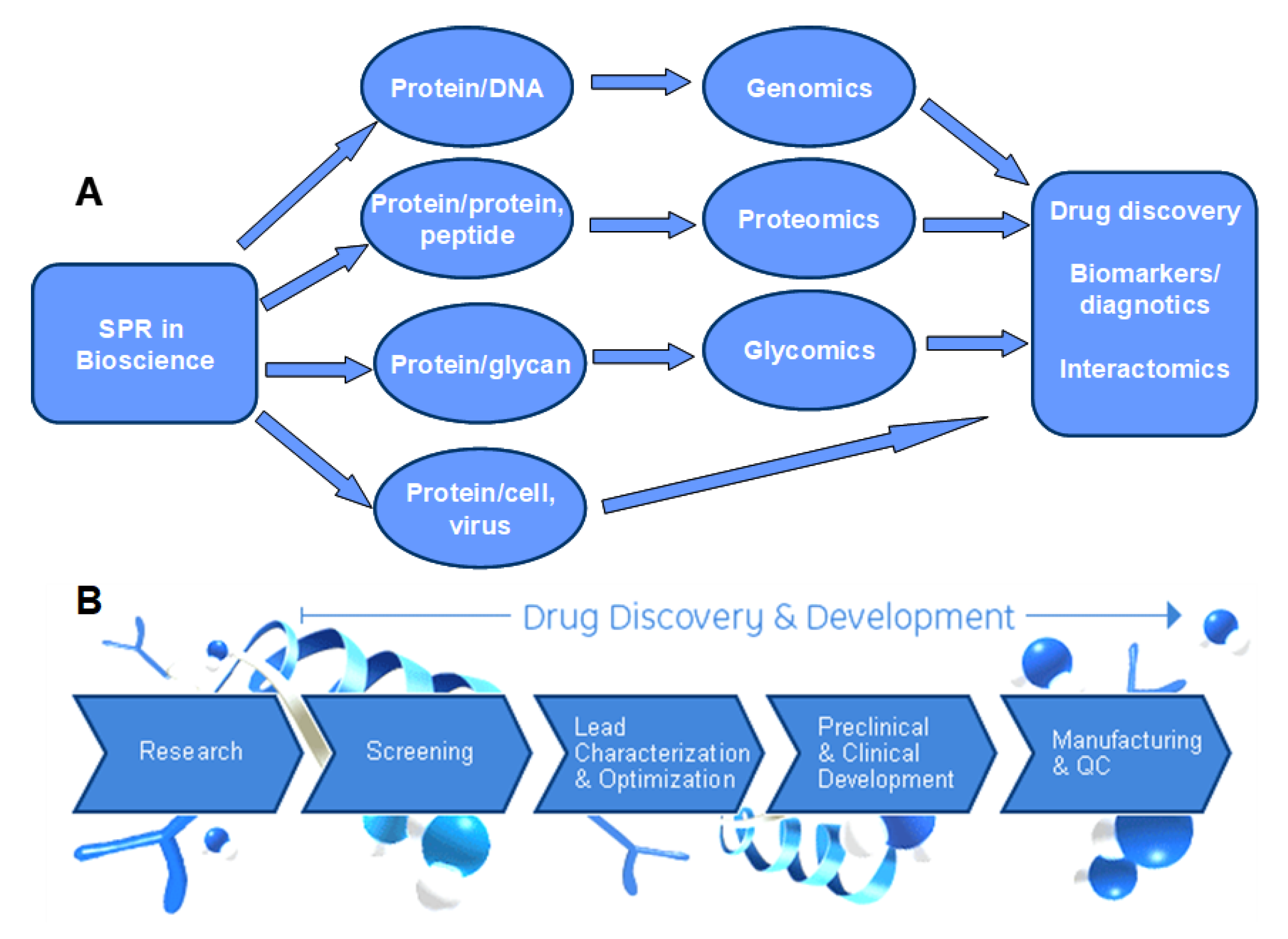
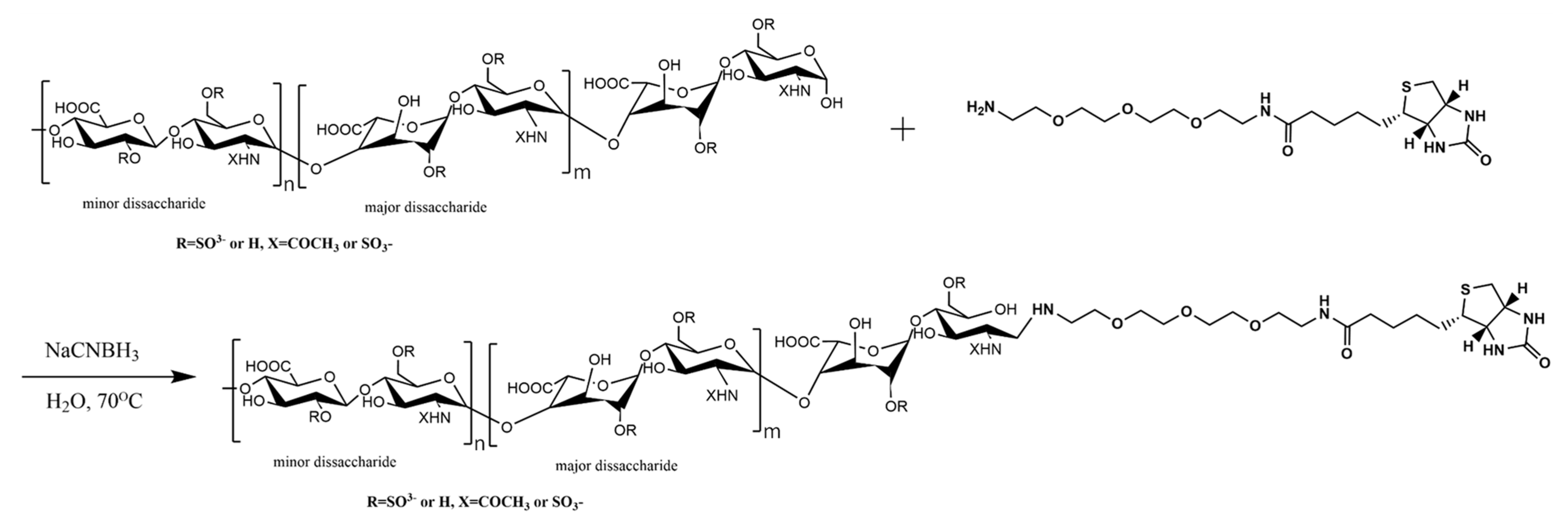
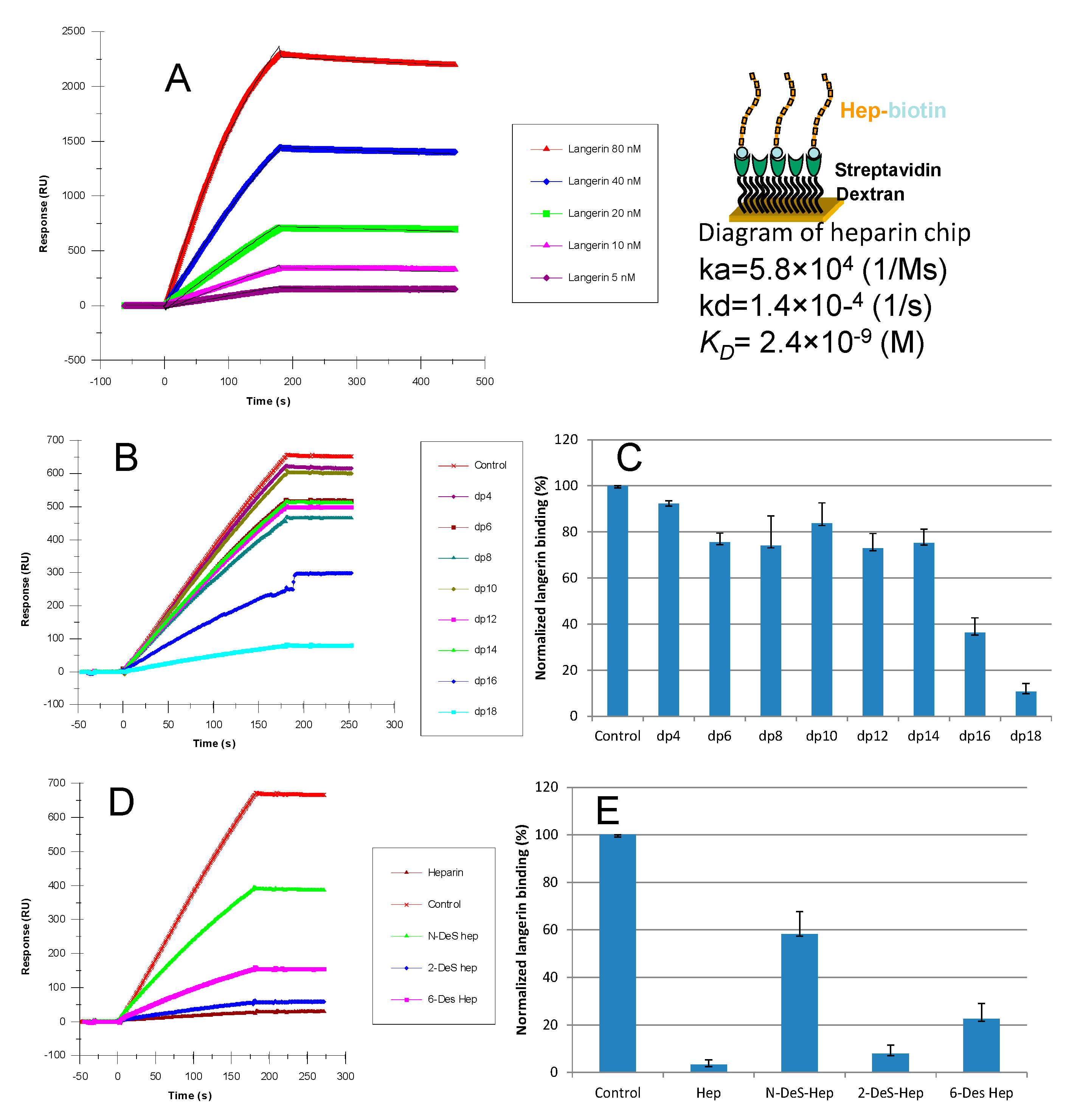

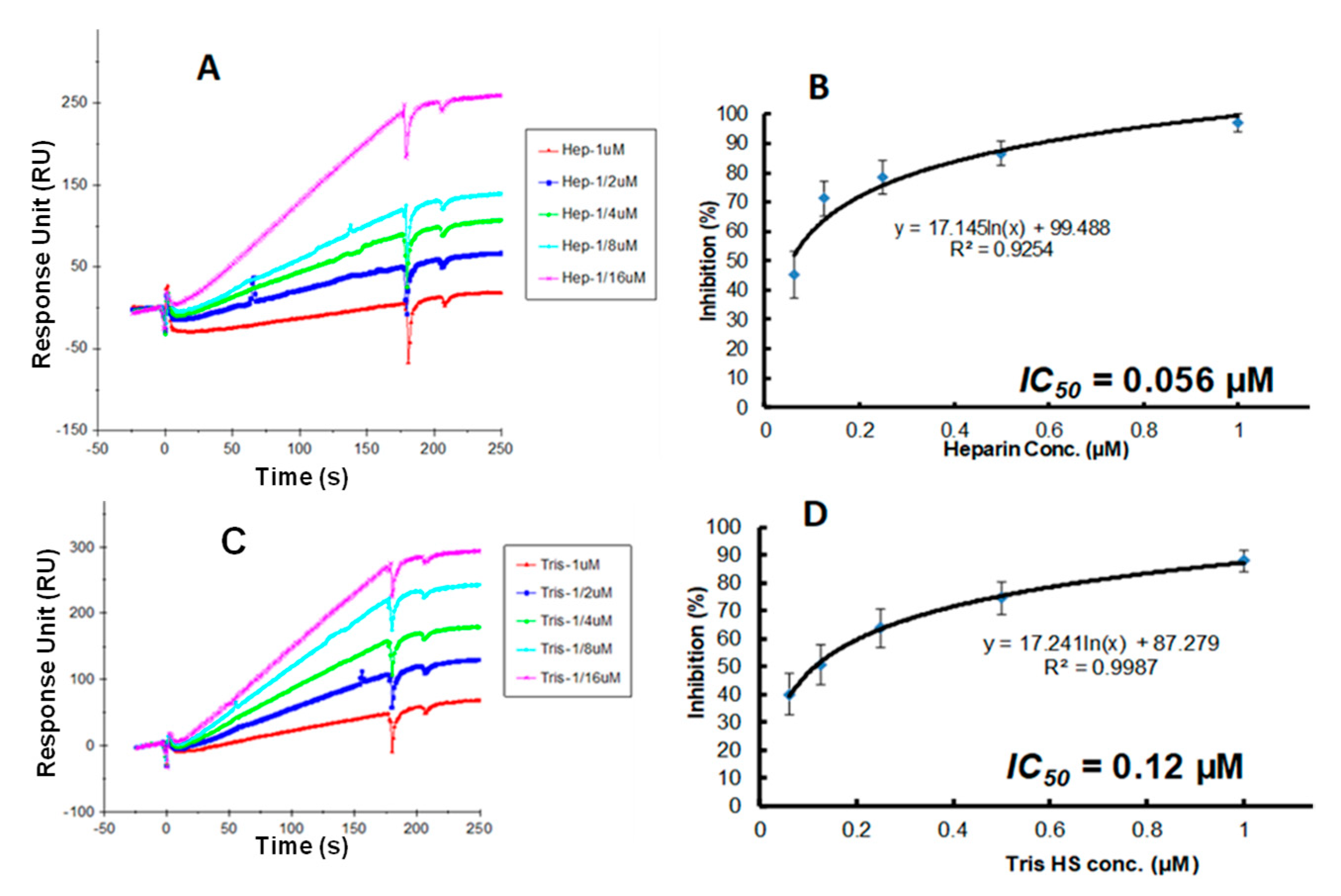
| Biomolecules/Pathogens | Examples | References |
|---|---|---|
| Amyloid Proteins | Tau protein and alpha-synuclein | [17,18] |
| Cell Adhesion Molecules (CAMs) | Cadherins, integrins, and selectins | [18,19,20,21,22,23] |
| Chemokines | Platelet factor 4, interleukin-8 (IL-8), and RANTES (CCL5) | [24,25,26] |
| Growth Factors and the Receptors | Fibroblast growth factors (FGFs), vascular endothelial growth factor (VEGF), and hepatocyte growth factor (HGF) | [27,28,29,30] |
| Lipoproteins | Low-density lipoproteins and apolipoprotein E (ApoE) | [31,32] |
| Pathogens | Viruses and viral proteins (e.g., HPV, Dengue virus, Herpes simplex virus, and HIV); bacteria (e.g., Listeria monocytogenes); and protozoa (e.g., malaria sporozoites) | [33,34,35,36,37,38,39,40] |
| Serpins | Antithrombin III, heparin cofactor II, and factor Xa | [41,42,43] |
Disclaimer/Publisher’s Note: The statements, opinions and data contained in all publications are solely those of the individual author(s) and contributor(s) and not of MDPI and/or the editor(s). MDPI and/or the editor(s) disclaim responsibility for any injury to people or property resulting from any ideas, methods, instructions or products referred to in the content. |
© 2025 by the authors. Licensee MDPI, Basel, Switzerland. This article is an open access article distributed under the terms and conditions of the Creative Commons Attribution (CC BY) license (https://creativecommons.org/licenses/by/4.0/).
Share and Cite
Datta, P.; Dordick, J.S.; Zhang, F. Applications of Surface Plasmon Resonance in Heparan Sulfate Interactome Research. Biomedicines 2025, 13, 1471. https://doi.org/10.3390/biomedicines13061471
Datta P, Dordick JS, Zhang F. Applications of Surface Plasmon Resonance in Heparan Sulfate Interactome Research. Biomedicines. 2025; 13(6):1471. https://doi.org/10.3390/biomedicines13061471
Chicago/Turabian StyleDatta, Payel, Jonathan S. Dordick, and Fuming Zhang. 2025. "Applications of Surface Plasmon Resonance in Heparan Sulfate Interactome Research" Biomedicines 13, no. 6: 1471. https://doi.org/10.3390/biomedicines13061471
APA StyleDatta, P., Dordick, J. S., & Zhang, F. (2025). Applications of Surface Plasmon Resonance in Heparan Sulfate Interactome Research. Biomedicines, 13(6), 1471. https://doi.org/10.3390/biomedicines13061471








